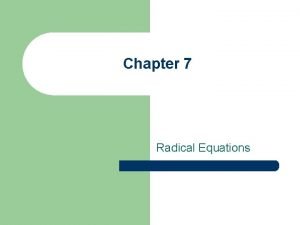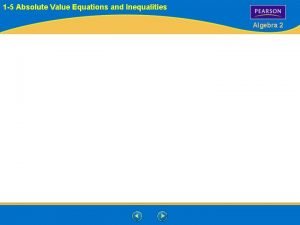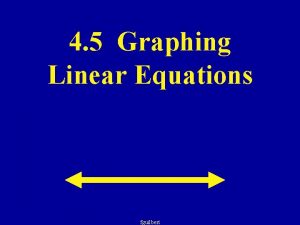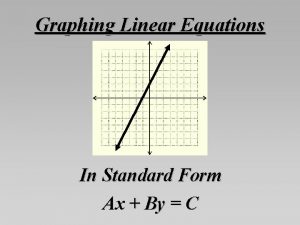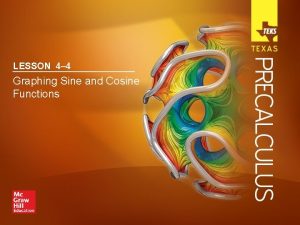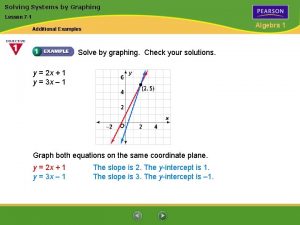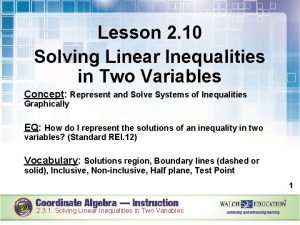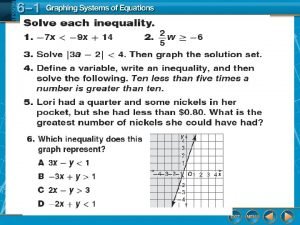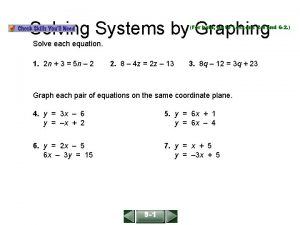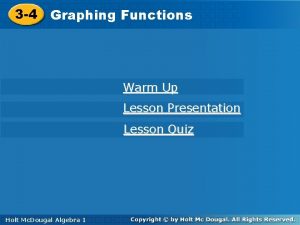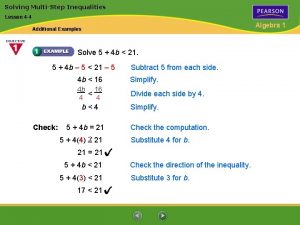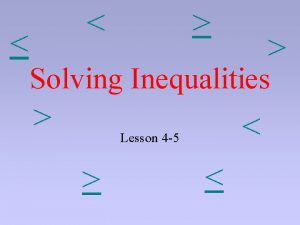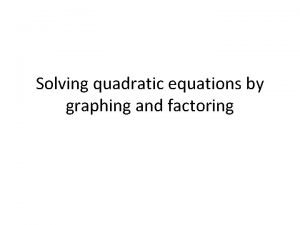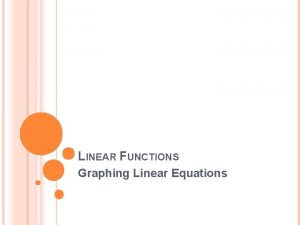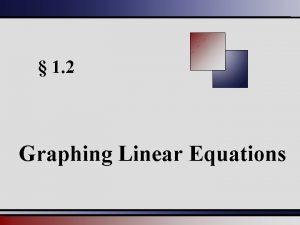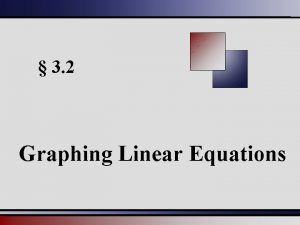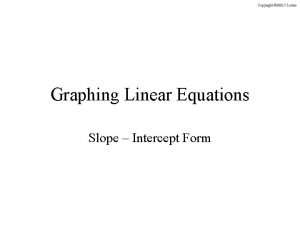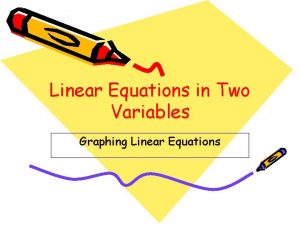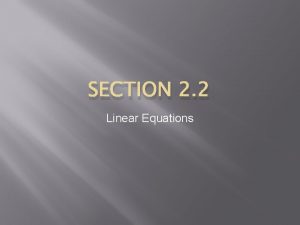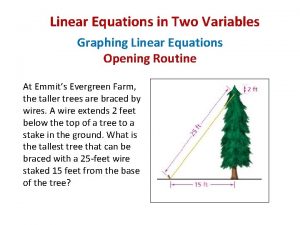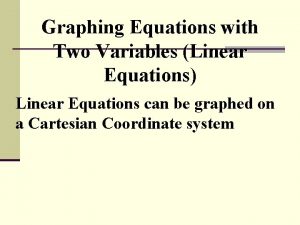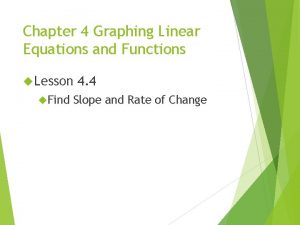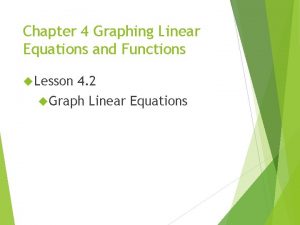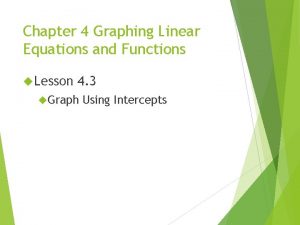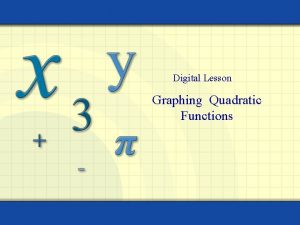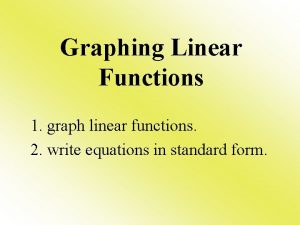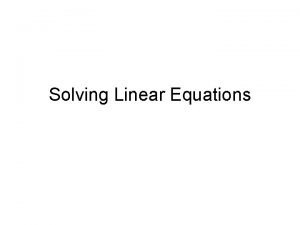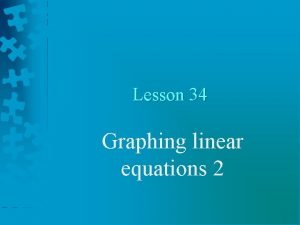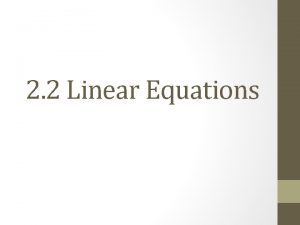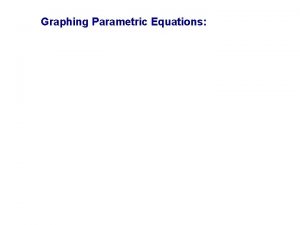Chapter 4 Graphing Linear Equations and Functions Lesson

























- Slides: 25

Chapter 4 Graphing Linear Equations and Functions Lesson 4. 1 Plot points in a coordinate plane

EXAMPLE 1 Name points in a coordinate plane Give the coordinates of the point. a. A b. B SOLUTION a. Point A is 3 units to the left of the origin and 4 units up. So, the x-coordinate is – 3, and the y-coordinate is 4. The coordinates are (– 3, 4).

EXAMPLE 1 Name points in a coordinate plane b. Point B is 2 units to the right of the origin and 3 units down. So, the x-coordinate is 2, and the y- coordinate is – 3. The coordinates are (2, – 3).

GUIDED PRACTICE 1. for Example 1 Use the coordinate plane in Example 1 to give the coordinates of points C, D, and E. SOLUTION C. Point C is 2 units up from the origin. So, the x-coordinate is 0 and the y-coordinate is 2. The coordinates are (0, 2).

GUIDED PRACTICE for Example 1 D. Point D is 3 units to the right of the origin and 1 units up. So, the x-coordinate is 3, and the ycoordinate is 1. The coordinates are (3, 1). E. Point E is 2 units to the left of the origin and 3 units down. So, the x-coordinate is – 2, and the ycoordinate is – 3. The coordinates are (– 2, – 3).

GUIDED PRACTICE for Example 1 2. What is the y-coordinate of any point on the x-axis? SOLUTION y-coordinate of any point on the x-axis is 0

EXAMPLE 2 Plot points in a coordinate plane Plot the point in a coordinate plane. Describe the location of the point. a. A(– 4, 4) b. B(3, – 2) c. SOLUTION a. Begin at the origin. First move 4 units to the left, then 4 units up. Point A is in Quadrant II. b. Begin at the origin. First move 3 units to the right, then 2 units down. Point B is in Quadrant IV. C(0, – 4)

EXAMPLE 2 c. Plot points in a coordinate plane Begin at the origin and move 4 units own. Point C is on the y-axis.

EXAMPLE 3 Graph a function Graph the function y = 2 x – 1 with domain – 2, – 1, 0, 1, and 2. Then identify the range of the function. SOLUTION STEP 1 Make a table by substituting the domain values into the function.

EXAMPLE 3 Graph a function STEP 2 List the ordered pairs: (– 2, – 5), (– 1, – 3), (0, – 1), (1, 1), (2, 3). Then graph the function.

EXAMPLE 3 Graph a function STEP 3 Identify the range. The range consists of the y-values from the table: – 5, – 3, – 1, 1, and 3.

GUIDED PRACTICE for Examples 2 and 3 Plot the point in a coordinate plane. Describe the location of the point. 3. A(2, 5) SOLUTION Begin at the origin. First move 2 units to the right, then 5 units up. Point A is in Quadrant I.

GUIDED PRACTICE 4. for Examples 2 and 3 B(– 1, 0) SOLUTION Begin at the origin and move 1 units to the left. Point B is on x-axis. 5. C(– 2, – 1) SOLUTION Begin at the origin. First move 2 units to the left, then 1 units down. Point C is in Quadrant III.

GUIDED PRACTICE for Examples 2 and 3 6. D(– 5, 3) SOLUTION Begin at the origin. First move 5 units to the left and then 3 units up. Point D is in Quadrant II.

GUIDED PRACTICE for Examples 2 and 3 1 7. Graph the function y = – 3 x + 2 with domain – 6, – 3, 0, 3, and 6. Then identify the range of the function. STEP 1 Make a table by substituting the domain values into the function.

GUIDED PRACTICE x – 6 – 3 0 3 6 for Examples 2 and 3 y=– 1 x+2 3 y = – 1 (– 6) + 2 = 4 3 y = – 1 (– 3) + 2 = 3 3 y = – 1 (0) + 2 = 2 3 y = – 1 (3) + 2 = 1 3 y = – 1 (6) + 2 = 0 3

GUIDED PRACTICE for Examples 2 and 3 STEP 2 List the ordered pairs: (– 6, 4), (– 3, 3), (0, 2), (3, 1), (6, 0). Then graph the function. STEP 3 Identify the range. The range consists of the y-values from the table: 0, 1, 2, 3 and 4.

EXAMPLE 4 Graph a function represented by a table VOTING In 1920 the ratification of the 19 th amendment to the United States Constitution gave women the right to vote. The table shows the number (to the nearest million) of votes cast in presidential elections both before and since women were able to vote.

EXAMPLE 4 Graph a function represented by a table Years before or since 1920 – 12 – 8 – 4 0 4 8 12 Votes (millions) 15 15 19 27 29 37 40 a. Explain how you know that the table represents a function. b. Graph the function represented by the table. c. Describe any trend in the number of votes cast.

EXAMPLE 4 Graph a function represented by a table SOLUTION a. The table represents a function because each input has exactly one output. b. To graph the function, let x be the number of years before or since 1920. Let y be the number of votes cast (in millions). The graph of the function is shown.

EXAMPLE 4 Graph a function represented by a table SOLUTION c. In the three election years before 1920, the number of votes cast was less than 20 million. In 1920, the number of votes cast was greater than 20 million. The number of votes cast continued to increase in the three election years since 1920.

GUIDED PRACTICE for Example 4 VOTING 8. The presidential election in 1972 was the first election in which 18 -year-olds were allowed to vote. The table shows the number (to the nearest million) of votes cast in presidential elections both before and since 1972. Years before or since 1972 – 12 – 8 – 4 0 4 8 12 Votes (millions) 69 71 73 78 82 87 93

GUIDED PRACTICE a. for Example 4 Explain how you know the graph represents a function. SOLUTION The table represents a function because each input has exactly one output.

GUIDED PRACTICE b. for Example 4 Graph the function represented by the table. SOLUTION b. To graph the function, let x be the number of years before or since 1972. Let y be the number of votes cast.

GUIDED PRACTICE c. for Example 4 Describe any trend in the number of votes cast. SOLUTION c. Before 1972, the number of votes cast increased by 2 million every 4 years. In 1972, the number increased by 5 million and continued to increase by more than 2 million every four years since 1972.
 Lesson 5 - graphing linear equations and inequalities
Lesson 5 - graphing linear equations and inequalities Chapter 3 graphing linear functions answer key
Chapter 3 graphing linear functions answer key Graphing linear and exponential functions
Graphing linear and exponential functions Lesson 7 - graphing radical equations and inequalities
Lesson 7 - graphing radical equations and inequalities Lesson 1-4 solving absolute value equations
Lesson 1-4 solving absolute value equations 4-5 graphing linear equations
4-5 graphing linear equations Graphing linear equations definition
Graphing linear equations definition Standard form of a linear equation definition
Standard form of a linear equation definition Graphing linear equations vocabulary
Graphing linear equations vocabulary Lesson 4-4 graphing sine and cosine functions
Lesson 4-4 graphing sine and cosine functions Lesson 7 solve systems of equations by graphing
Lesson 7 solve systems of equations by graphing Lesson 16-2 graphing inequalities in two variables
Lesson 16-2 graphing inequalities in two variables 6-1 graphing systems of equations
6-1 graphing systems of equations Lesson 9.1 solving linear systems by graphing answer key
Lesson 9.1 solving linear systems by graphing answer key 11-1 solving linear systems by graphing
11-1 solving linear systems by graphing 3-4 graphing functions
3-4 graphing functions Lesson 5-2 graphing polynomial functions answers
Lesson 5-2 graphing polynomial functions answers Penyelesaian persamaan simultan
Penyelesaian persamaan simultan Differences between linear and nonlinear equations
Differences between linear and nonlinear equations Eliminasi gauss naif
Eliminasi gauss naif Lesson 4 - solving linear equations and inequalities
Lesson 4 - solving linear equations and inequalities Lesson 4 - solving linear equations and inequalities
Lesson 4 - solving linear equations and inequalities Solving quadratic equations by graphing and factoring
Solving quadratic equations by graphing and factoring How to write an equation in slope intercept form
How to write an equation in slope intercept form 1-5 solving inequalities answers
1-5 solving inequalities answers Lesson 3 linear equations in x
Lesson 3 linear equations in x



